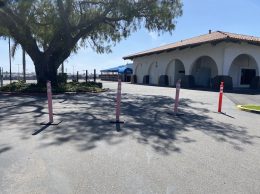Federal regulators should stop dragging their heels and release requested information about the oil pipelines that run through the Tri-Counties immediately.
Business Times staff writer Alex Kacik reports in this issue that the Environmental Defense Center has filed a lawsuit against the federal Pipeline and Hazardous Materials Safety Administration, alleging that the agency is refusing to release the information sought.
The EDC and Santa Barbara Channelkeepers sent a Freedom of Information Act request to PHMSA on May 22 and PHMSA has yet to fulfill the FOIA request, according to the complaint.
Requested are all records regarding the most recent internal inspection of Line 901, which was conducted in 2012, and details of all other inspections of Line 901 since 2013 such as maintenance data, monitoring information, incident reports and repair logs.
The heavily corroded Line 901 was responsible for the Refugio oil spill that soiled the Gaviota Coast on May 19, when the pipeline leaked up to 142,800 gallons. Line 901, and its connecting Line 903 that transports oil to refineries, remain shut down.
The EDC filed a second lawsuit against the federal Bureau of Safety and Environmental Enforcement for allegedly not fulfilling what the BSEE said was a “voluminous” FOIA request.
The request asked for all internal and external Outer Continental Shelf pipeline inspection reports from 2011. These pipelines transport water, natural gas, oil and other hazardous materials to and from the offshore oil platforms in the Santa Barbara Channel.
EDC attorneys argue that more transparency is not only needed regarding what went wrong with Line 901 but also how future disasters involving other pipelines in Santa Barbara and Ventura counties and those serving offshore oil platforms can be avoided.
The EDC also requested inspection data from M-143 and Tosco Oil pipelines that convey oil produced in Ventura County. M-143, which is owned by Crimson Pipeline, runs from Carpinteria to Ventura and Tosco’s runs from Ventura to Los Angeles. The EDC asked for the oil spill response plans, incident reports and all other records.
An agency typically has 20 workdays to respond to a FOIA request and state whether the agency will or will not gather and provide the information requested. PHMSA said on May 26 that its average processing time for a FOIA request was 54 workdays.
We’re not usually on the same side as the EDC when it goes to court. But it is outrageous how little information about Line 901 and other oil pipelines in the Tri-Counties has been released more than six months after the oil spill and subsequent FOIA requests. Tri-county residents deserve a full accounting of the possible danger that lurks under their feet.
We agree with PHMSA’s new regulations for pipeline oversight proposed in October that would extend reporting requirements to all gathering lines, including rural lines and ones that transport oil through gravity that are currently exempt.
Greater transparency is essential if we are to have an informed citizenry capable of making reasoned choices regarding oil production and transportation in the Tri-Counties.






 Print
Print Email
Email


















Thank you for drawing attention to the new proposed rules for hazardous liquid pipelines proposed by the Pipeline & Hazardous Materials Safety Administration (PHMSA). It’s certain that industry will comment heavily on these proposed rules; the public voice is generally much weaker. We encourage all those interested in the safety of oil pipelines to comment. For a summary of the rules, talking points, and info on how to comment, have a look at our website: http://pstrust.org/finding-info-and-getting-involved/participation-opportunities/.